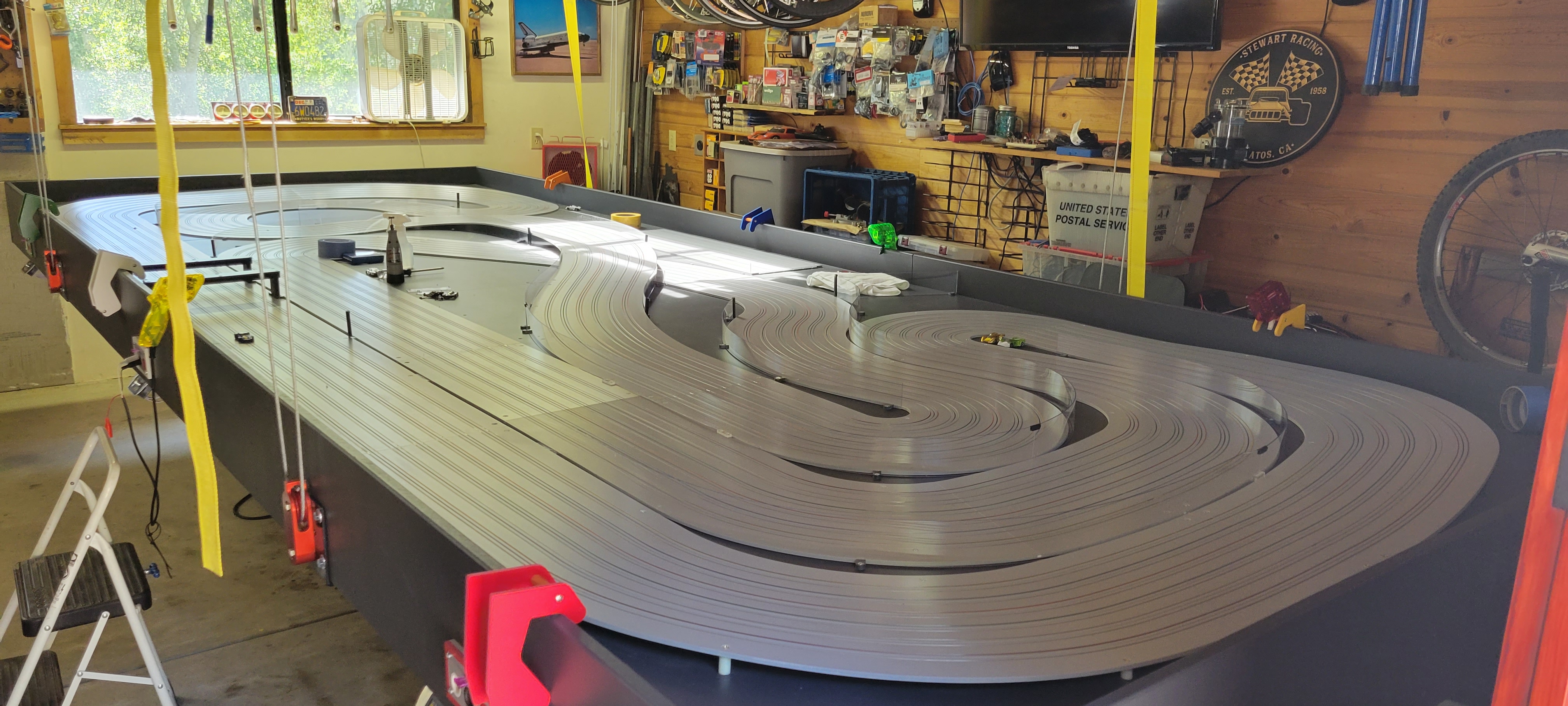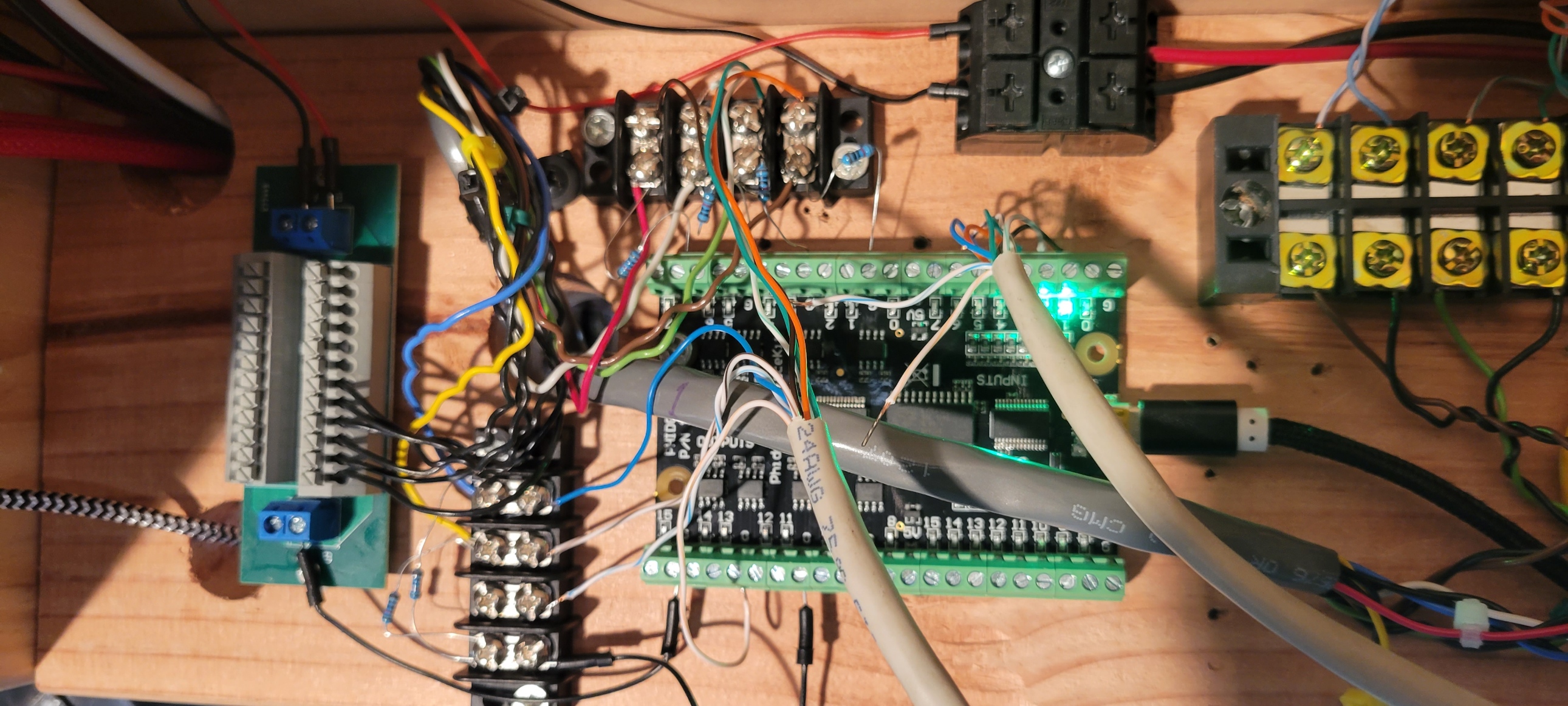
 Well, the saga continues. After three weeks of chasing the pit detection issue, that problem actually turned out to be solvable by something I had already tried. In the end, the IR sensors had to have pull-down resistors to work properly with a Phidget card. Apparently, the Trackmate SCL3 card has built-in pull-down resistors, which is why it works flawlessly.
Well, the saga continues. After three weeks of chasing the pit detection issue, that problem actually turned out to be solvable by something I had already tried. In the end, the IR sensors had to have pull-down resistors to work properly with a Phidget card. Apparently, the Trackmate SCL3 card has built-in pull-down resistors, which is why it works flawlessly.
So, after several weeks of trying just about everything else possible, I went full circle back to IR sensor terminations to ground. Yes, I tested that early on but only on one lane, which apparently had a bad sensor to begin with (CCP junk!).

So, after a nice celebration of finally finding a solution to the pit-in detection issues, I then discovered that SlotTrak was failing to count the lap every time a car exited the pits. You could hear the lap trigger audio and see the lap time change, but the software does not add that lap. Seems to be an obvious software problem. I’m waiting on Michael to do some further testing on his end to confirm. This issue is also puzzling since I should have noticed this all along but didn’t.
Anyway, SR3 is pretty much only straight-up racing until the fuel feature problems are sort it out. RC is not an option because it doesn’t support Phidget cards for fuel racing, only Arduino, which SlotTrak doesn’t support at all.
As for the frustrating missed Pit-In problem we see on SR2, that problem has been very elusive and I don’t have a solution yet. As some of you have personaly experienced, we still see missed pit entries occasionally and I have been able to duplicate it on every lane when testing manually, but not when actually driving. Obviously don’t want to do fuel racing on either track until these issues are fixed.
So there is some good news, it seems that G-Man has his track up and running, he shot me a video of a car cutting laps. Maybe he’ll start racing soon and you guys can dust off your cars and have some fun on his track. I don’t think he’ll have a dual gantry system going anytime soon but he should be able to race and/or test.

In other news, Race Coordinator (RC) and I are actually working on a feature enhancement for RC that supports cycling the power when you run out of fuel. This is a nice feature that SlotTrak has supported for quite some time. I’ve been bugging Dave (RC developer) to add this feature but he’s always claimed nobody but me wants it, which is strange.
Anyway, if Dave can find a way to support that feature, we can use RC on both tracks and shelve SlotTrak until they decide to support Arduino hardware instead of all these other proprietary hardware devices. I love SlotTrak but this is getting frustrating, to say the least.
Steve, why do you want to run both? Well, this is a perfect example of why right now. We could have had two race days by now if either or both of the RMS systems supported the same hardware.
So, for now, I’m going to keep working on the intermittent pit-in detection problem with SlotTrak on SR2. No idea what is going on there, sounds like it could be a sensor termination issue but SR2 uses a Trackmate card to run SlotTrak, which has built-in sensor terminations. RC uses an Arduino card and does not have the intermittent pit-in detection problem, works 100 times out of 100 entries.
So, at the moment, we can run fuel races using RC on SR2 and/or run regular lap or timed races on SR3. I’m opening up both tracks this Sunday to flush out any unknown issues and get some feedback on things.
Please let me know if you’re interested in cutting some laps Sunday, April 10, 2022. Gates open at 10:00 AM, usual lunch routine, and gates close at 7:00 PM.
Oh, if you have any L10 cars, please bring them. I’d like to see if the SR3 Phidget card can handle the pit-entry speeds of the faster cars.
Okay, shut-up and drive!



 Steve may not have seen the single-car detection issue I’m seeing because his lap timing gantry is only 18 inches from the final corner (SR3’s final corner is nearly six feet from the lap timing gantry). However, he did encounter the simultaneous car detection problem, which I duplicated on my track tonight.
Steve may not have seen the single-car detection issue I’m seeing because his lap timing gantry is only 18 inches from the final corner (SR3’s final corner is nearly six feet from the lap timing gantry). However, he did encounter the simultaneous car detection problem, which I duplicated on my track tonight. Another option for solving this would be to add a 1.5-in long piece of black tape to the back of each car. Not sure if everyone would go for that but it is way cheaper and quicker. And, just think…you could paint or otherwise detail the tape for concourse consideration!
Another option for solving this would be to add a 1.5-in long piece of black tape to the back of each car. Not sure if everyone would go for that but it is way cheaper and quicker. And, just think…you could paint or otherwise detail the tape for concourse consideration!
 I don’t have the track sections connected to each other yet but I tested the gantries and all the power control logic by hand and with a test car on one section. Both seemed to work as expected and nothing caught fire.
I don’t have the track sections connected to each other yet but I tested the gantries and all the power control logic by hand and with a test car on one section. Both seemed to work as expected and nothing caught fire. Before I get to the above, I’m going to lift the track to the ceiling and clean out the entire garage. Need to blow and vacuum the whole place out due to all the damn sawdust, wire insulation, tie-wrap debris, etc. Also need to get rid of a bunch of bikes and bike parts. This track takes up a bit more space and will force me to get rid of stuff that has been hanging on the walls or just laying around forever. I also need to wash my motorcycles before the sawdust becomes permanent.
Before I get to the above, I’m going to lift the track to the ceiling and clean out the entire garage. Need to blow and vacuum the whole place out due to all the damn sawdust, wire insulation, tie-wrap debris, etc. Also need to get rid of a bunch of bikes and bike parts. This track takes up a bit more space and will force me to get rid of stuff that has been hanging on the walls or just laying around forever. I also need to wash my motorcycles before the sawdust becomes permanent. So, where are things? Well, the table and track roadway placement has been completed. The track power distribution system is complete and tested. While there are still technical hurdles to overcome, the goal of supporting different voltage levels for each lane–by the driver–has been achieved. It’s not completely ready, but drivers can select any voltage they’d like to run when testing or practicing. This means you can practice/test any car, at any voltage, at any time racing is not underway. Think about that…you no longer have to restrict yourself to 15v, 12v, 20v, or whatever. You can go to any open lane, set the “lane” voltage (at the driver station), and run your car.
So, where are things? Well, the table and track roadway placement has been completed. The track power distribution system is complete and tested. While there are still technical hurdles to overcome, the goal of supporting different voltage levels for each lane–by the driver–has been achieved. It’s not completely ready, but drivers can select any voltage they’d like to run when testing or practicing. This means you can practice/test any car, at any voltage, at any time racing is not underway. Think about that…you no longer have to restrict yourself to 15v, 12v, 20v, or whatever. You can go to any open lane, set the “lane” voltage (at the driver station), and run your car. Other than six lanes, and a much larger layout, SR3 is expected to support the same racing features that SR2 supports. One small difference will be a slight increase in pit spacing. SR3’s dual gantries will be spread slightly further apart to compensate for the higher pit entry speeds.
Other than six lanes, and a much larger layout, SR3 is expected to support the same racing features that SR2 supports. One small difference will be a slight increase in pit spacing. SR3’s dual gantries will be spread slightly further apart to compensate for the higher pit entry speeds.
 So, SR3 is coming along nicely. My garage is a complete disaster but the new track is going to be quite cool. Yea, lots more work to do, but it’s getting close. Really only need to wire the gantries up and I can start testing things. The 6-lane, dual gantry setup adds some complexity and delay. I had planned to just use the usual RJ-45 twisted-pair cable to handle that but RJ-45 only provides 4-pair, which doesn’t quite handle a 6-lane dual gantry setup (need 6-pair x2). Yea, yea, I could make it work but decided to find some 6-pair cable to handle this. Sadly, it’ll take a week or so to arrive.
So, SR3 is coming along nicely. My garage is a complete disaster but the new track is going to be quite cool. Yea, lots more work to do, but it’s getting close. Really only need to wire the gantries up and I can start testing things. The 6-lane, dual gantry setup adds some complexity and delay. I had planned to just use the usual RJ-45 twisted-pair cable to handle that but RJ-45 only provides 4-pair, which doesn’t quite handle a 6-lane dual gantry setup (need 6-pair x2). Yea, yea, I could make it work but decided to find some 6-pair cable to handle this. Sadly, it’ll take a week or so to arrive.